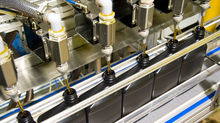Lubricant Selection in Centrifugal Compressors
Centrifugal compressors, also known as turbo-compressors, are designed to offer an advanced life cycle cost with lower maintenance due to its simpler structure and maintaining of a steady flow, subjecting the unit to less vibration and noise.
The designation of centrifugal implies that the gas flow through the compressor is radial, and that the energy transfer is caused from a change in the centrifugal forces. These systems provide high flow rates with relatively low maintenance requirements. The lubricant in these units do not come in contact with the air stream resulting in ISO 8573-1 (2010) Class 0, 100% oil-free air downstream.
Differences in Centrifugal Compressor Bearing Technology
Centrifugal compressors are designed with two journal bearings to support the weight of the rotor and position it appropriately within the stationary elements. There is also a thrust bearing used to maintain the rotor in the desired axial position.
The journal bearings most commonly found in centrifugal compressors are of the floating tilt pad type. These bearings are designed to equalize the load from the rotor and are continuously lubricated with a light turbine oil.
Ingersoll Rand Centac® centrifugal compressors, now called MSG® Centac®, have increased stability of the rotor assembly, allowing the use of simpler fixed tilted pad journal bearings with no moving parts. With the rotor spinning on the oil film, they are completely non-contact, offering virtually unlimited life and maximum efficiency with 2-3 times the potential lifespan of floating tilt pad bearings.
Differences in Lubricant Technology
Most centrifugal compressors operate well using a synthetic hydrocarbon-based turbine oil with an ISO viscosity grade of 32 or 46. These products exhibit good oxidative stability and prevention of acidity, sludge and varnish formation in stable environments with controlled temperatures. These systems can run for years on the same fluid, but as boundaries of useful life are pushed, the risk of fluid breakdown increases exponentially.
Laboratory and field testing has shown that many centrifugal compressors with floating tilt pad bearings can tolerate some varnish formed by these hydrocarbon-based turbine oils. The bearings can retract and accept this varnish, adjusting the way the tilt pad manages the rotor’s load.
Manufacturers of centrifugal compressors with fixed pad bearings have adopted Polyalkylene Glycol (PAG) based lubricants to eliminate the problem of bearing failure caused by varnish formation. In these machines, there is a clearance of about 0.001”. If even 0.0002” (two ten-thousandths) of varnish forms on this surface, it has the potential to change rotor dynamics, resulting in an increase of vibrations. Ultimately, there is a thermal rise at the bearing, and the babbit on the bearings begin to deform. On a pinion/impeller assembly turning as much as 50,000 RPM, high vibration shutdown, failure and a costly rebuild follows. The unique degradation process of a PAG results in the molecules breaking down into smaller fragments, rather than cross-linking to form insoluble varnish plaques on bearing surfaces. It is for this reason that systems with fixed tilt pad bearings are highly recommended to utilize PAG technology in preventing premature bearing failure.

Lubricant Comparisons
For use in MSG® Centac® compressors, the unique properties exhibited in PAG centrifugal compressor lubricants include excellent lubricity, high-temperature stability, resistance to sludge and varnish formation, as well as good additive response. SA Performance’s SAP 7500 is a true equivalent to the Ingersoll Rand Techtrol Gold fluid.

For most all other centrifugal compressors, synthetic hydrocarbon technologies are utilized. Similar to Ingersoll Rand TurboBlendTM 46, Citgo Pacemaker 32, Chevron GST Premium 32 and Mobil DTE Light, the SA Performance SAP 12500 series utilizes the same synthetic base oils along with an additive complex to ensure an extended, trouble-free operation.
For those facilities requiring the use of NSF H-1 approved lubricants in all applications, regardless of whether there is a risk for incidental food contact, SA Performance also offers SAP 12700 series to meet these requirements.
Conclusion
Operating environment, machine condition, lubricant condition, and maintenance practices all have a direct impact on fluid and bearing performance. Care should be taken towards correct lubricant selection based on equipment type and conditions to ensure longevity.





















